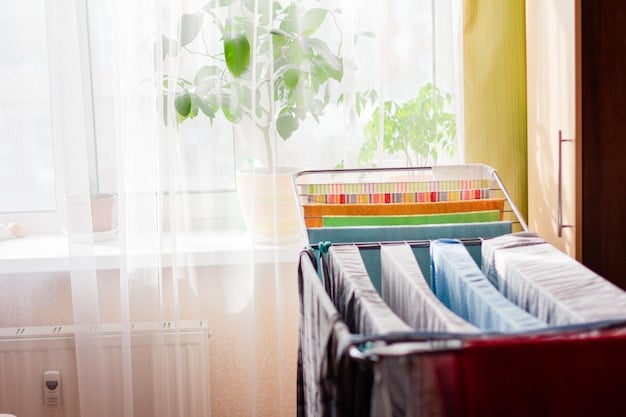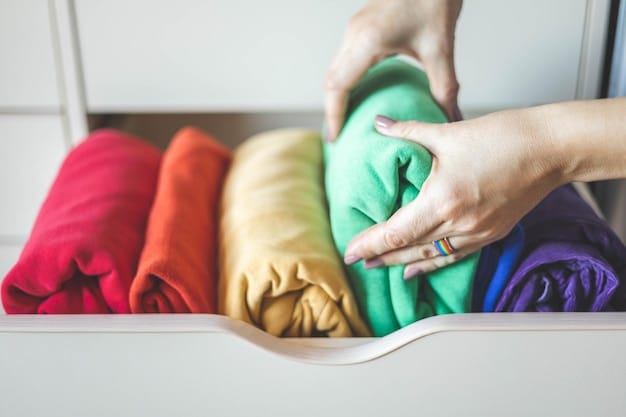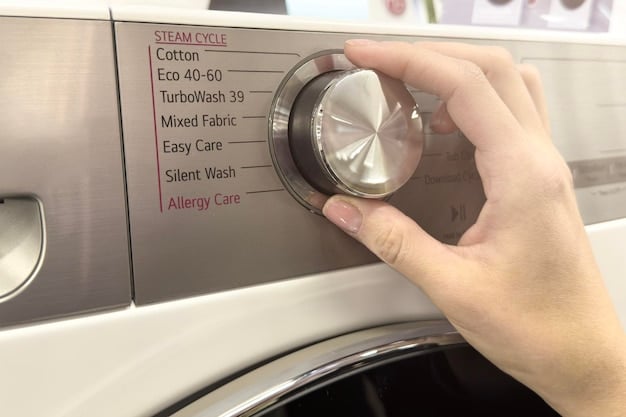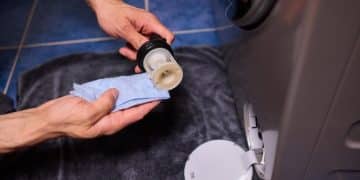DIY Laundry Hacks: Save $400/Year & Extend Clothes Life

DIY laundry hacks offer simple, cost-effective solutions to extend the life of your clothes, reduce wear and tear, and potentially save you around $400 a year through reduced detergent use, fewer replacements, and lower energy consumption.
Discover how simple, do-it-yourself laundry hacks can revolutionize your routine. Not only do they save you money, but they also extend the lifespan of your wardrobe. Let’s dive into some practical tips with these DIY laundry hacks: Extend the life of your clothes and save $400 a year.
Smart Sorting Strategies
Sorting laundry correctly is the cornerstone of any effective laundry routine. It’s more than just separating whites from colors; it involves considering fabric types, soil levels, and washing instructions to prevent damage and ensure each item receives appropriate care.
Color Categorization
Divide your clothes into three main categories: whites, lights, and darks. Washing similar colors together prevents dye transfer, keeping your whites bright and your darks from fading. This is a crucial step to maintain the original appearance of your garments.
Fabric Separation
Separate delicate items like lace and silk from heavier fabrics such as denim and towels. This prevents the more abrasive materials from damaging your finer clothes. Consider using mesh laundry bags for extra protection. Proper sorting extends the life of delicate items considerably.
- ✔️ Always check the care label before sorting.
- ✔️ Separate heavily soiled items from lightly soiled ones.
- ✔️ Keep lint-producing fabrics (like towels) away from lint-attracting ones (like corduroy).
- ✔️ Ensure all pockets are empty to avoid damage to clothes and machines.

By implementing these sorting strategies, you protect your clothes from premature wear and tear, keeping them looking newer for longer. Proper sorting is a straightforward yet effective way to enhance your laundry habits and save money in the long run.
Eco-Friendly Detergent Choices
Selecting the right detergent is crucial for both cleaning effectiveness and environmental sustainability. Eco-friendly detergents not only reduce your carbon footprint but are also gentler on your clothes. Making informed choices can contribute to significant savings and better fabric care.
Understanding Ingredients
Look for detergents that are free from harsh chemicals like phosphates, chlorine, and artificial fragrances. These ingredients can damage fabrics and cause skin irritations. Opt for biodegradable, plant-based formulas that are effective and gentle.
Concentrated Formulas
Choose concentrated detergents that require less product per load. These formulas reduce packaging waste and are more cost-effective in the long run. Follow the recommended dosage instructions carefully to avoid over- or under-using the detergent.
- ✔️ Consider using laundry sheets or pods for convenience and reduced waste.
- ✔️ Explore natural alternatives like soap nuts or homemade detergents made from borax, washing soda, and essential oils.
- ✔️ Check for certifications like EcoLogo or Safer Choice to ensure the product meets environmental standards.
- ✔️ Rinse clothes thoroughly to remove any detergent residue that can cause irritation or stiffness.
Choosing eco-friendly detergents is a simple change that can lead to significant environmental and financial benefits. By prioritizing gentle, sustainable products, you protect your clothes, your health, and the planet.
Optimal Washing Temperatures
Using the correct water temperature is vital for effective cleaning and preserving the quality of your clothes. Different fabrics and soil levels require different temperatures to achieve the best results while minimizing damage.
Cold Water Washing
Washing clothes in cold water is energy-efficient and gentle on most fabrics. Cold water is suitable for lightly soiled clothes, delicates, and bright colors as it prevents fading and shrinkage. This practice can significantly reduce your energy bill.
Warm Water Washing
Warm water is ideal for moderately soiled clothes and synthetic fabrics. It provides a good balance between cleaning power and fabric care. Use warm water for items that need a bit more cleaning but are not heavily stained.

Selecting the right water temperature can prolong the life of your clothes by minimizing wear and tear. Experiment with different temperatures based on your laundry needs and monitor the results to find the perfect balance for your wardrobe.
Gentle Drying Techniques
The drying process can be particularly harsh on clothes, leading to shrinkage, fading, and damage. Employing gentle drying techniques is essential to extend the life of your garments and reduce energy consumption.
Air Drying Strategies
Air drying is the gentlest method for drying clothes. Hang delicate items on a clothesline or drying rack to avoid the high heat of a dryer. This technique is especially beneficial for preserving the elasticity and color of your clothes.
Low Heat Settings
If you must use a dryer, opt for the low heat or delicate setting. High heat can damage fibers, causing clothes to shrink or wear out faster. Keep the dryer vent clean to ensure efficient drying and prevent overheating.
- ✔️ Turn clothes inside out before drying to minimize fading.
- ✔️ Avoid over-drying clothes, as this can weaken fibers.
- ✔️ Use dryer balls to help separate clothes and reduce drying time.
- ✔️ Remove clothes from the dryer promptly to prevent wrinkles and stiffness.
Gentle drying techniques are a key component of any laundry care routine. By prioritizing air drying and low heat settings, you can significantly extend the lifespan of your clothes and reduce your environmental impact.
Effective Stain Removal Methods
Stains are inevitable, but knowing how to treat them properly can prevent them from becoming permanent. Effective stain removal methods can save your clothes from being discarded prematurely.
Immediate Action
The key to successful stain removal is to act quickly. Treat stains as soon as possible before they have a chance to set. Blot the stain gently with a clean cloth, avoiding rubbing, which can spread the stain.
Natural Stain Removers
Explore natural stain removers like vinegar, baking soda, and lemon juice. These ingredients are effective and safe for most fabrics. Test the solution on an inconspicuous area first to ensure it doesn’t damage the material.
- ✔️ Use a pre-treatment stain remover before washing heavily soiled items.
- ✔️ Soak stained clothes in cold water for several hours before washing.
- ✔️ Avoid using hot water on protein-based stains, as this can set them.
- ✔️ Always check the care label for specific stain removal instructions.
Effective stain removal methods are an essential skill for preserving your clothing. By acting quickly and using the right techniques, you can keep your clothes looking fresh and new for longer.
Proper Storage Solutions
How you store your clothes can significantly impact their longevity. Proper storage solutions protect your garments from damage, pests, and environmental factors.
Folding and Hanging
Fold clothes neatly to prevent wrinkles and unnecessary wear. Hang items that are prone to wrinkling, such as dress shirts and blouses, in a well-ventilated closet. Use padded hangers to maintain the shape of your clothes.
Seasonal Storage
When storing seasonal clothes, clean them thoroughly before packing them away. Use airtight containers or garment bags to protect them from dust, moisture, and pests. Store clothes in a cool, dry place away from direct sunlight.
- ✔️ Use cedar blocks or lavender sachets to repel moths and insects.
- ✔️ Avoid overfilling closets and drawers to prevent clothes from being crushed.
- ✔️ Rotate your wardrobe periodically to ensure all items are worn and not forgotten.
- ✔️ Consider using fabric protectors to guard against spills and stains.
Proper storage solutions are a vital component of maintaining your wardrobe. By following these simple guidelines, you can protect your clothes from damage and extend their lifespan, saving money and reducing waste.
Mending and Alterations
Instead of discarding clothes with minor damages, consider mending or altering them. These practices can breathe new life into old garments and save you money on replacements.
Basic Sewing Skills
Learn basic sewing skills like patching holes, replacing buttons, and hemming pants. These skills can extend the life of your clothes and save you money on tailoring services. There are many online tutorials and workshops available to help you get started.
Professional Alterations
For more complex repairs or alterations, seek the help of a professional tailor. Alterations can transform ill-fitting clothes into perfectly fitting ones, giving them a new lease on life. Investing in alterations can significantly enhance your wardrobe’s versatility and longevity.
- ✔️ Regularly inspect your clothes for signs of wear and tear.
- ✔️ Keep a sewing kit handy for quick repairs.
- ✔️ Consider upcycling old clothes into new items.
- ✔️ Support local tailors and repair shops in your community.
Mending and alterations are valuable skills that can help you extend the life of your clothes and reduce textile waste. By embracing these practices, you can save money, express your creativity, and contribute to a more sustainable lifestyle.
| Key Point | Brief Description |
|---|---|
| 🧺 Sorting Clothes | Separate by color and fabric to prevent damage. |
| 🌱 Eco-Friendly Detergent | Use plant-based, biodegradable formulas for gentle cleaning. |
| 🌡️ Washing Temperatures | Wash in cold water for most items; use warm for synthetics. |
| 🧵 Mending Clothes | Repair minor damages to extend the life of garments. |
Frequently Asked Questions
▼
Sort laundry by color (whites, lights, darks) and fabric type (delicates, heavy fabrics). This prevents dye transfer and protects delicate items from damage during washing.
▼
Use concentrated detergent and follow dosage instructions carefully. Consider making your own detergent with borax, washing soda, and essential oils for a cost-effective alternative.
▼
Cold water is ideal for most clothes as it saves energy and prevents fading. Use warm water for synthetics. Hot water should be reserved for heavily soiled items.
▼
Air dry clothes whenever possible. If using a dryer, choose the low heat setting and avoid over-drying. Remove clothes promptly to prevent shrinkage and stiffness.
▼
Vinegar, baking soda, and lemon juice are effective natural stain removers. Apply them to stains immediately and test on an inconspicuous area first to avoid damaging the fabric.
Conclusion
By integrating these DIY laundry hacks into your routine, you can significantly extend the life of your clothes and potentially save around $400 per year. Simple changes like proper sorting, eco-friendly detergent choices, optimal washing temperatures, gentle drying techniques, effective stain removal methods, proper storage solutions and mending/alterations ensure that you can improve your wardrobe’s lifespan and reduce your environmental impact.





